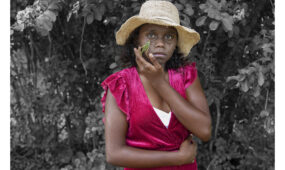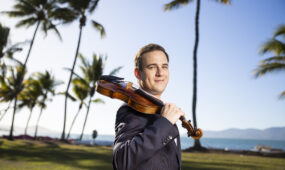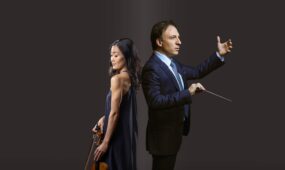Ghost set to work its magic on Adelaide
InReview
Illusionist Paul Kieve, the man behind the magic in stage show Ghost the Musical, got his lucky career break when he was just 16 years old.

“I was asked to perform magic in the pop video for the debut single of a group called Sade,” he tells InDaily.
“The single was ‘Your Love is King’.”
After that, there was no going back. In his 30-year career he has created magic effects for more than 100 productions, worked on films such as Hugo and Harry Potter and the Prisoner of Azkaban, and tutored actors such as Ben Kingsley and Daniel Radcliffe in the art of illusion.
Here, Kieve reveals some of the magic audiences will see in Ghost the Musical, the stage show based on the hit 1990 film starring Patrick Swayze and Demi Moore, which opens at the Adelaide Festival Centre this week.
What are some of the key scenes in which illusion is used in Ghost the Musical and what type of ‘magic’ will audiences witness?
The main areas where illusion is used are around the various experiences that Sam has as a ghost. They include scenes in the story where a soul splits from the body, so we see the physical body and then the spirit body split from it, and where Sam is learning “skills” as a ghost.
Specific to Bruce Joel Rubin’s wonderful story are moments where a ghost can step inside the physical body of a living person.
Illusion comes into play when we see things through the eyes of a living person: seeing Sam materialise; seeing objects move on the subway train as if by invisible force; seeing objects move of their own accord. This is often to do with the point of view that the story is told. We sometimes see the world through the ghost of Sam’s eyes (and see the ghosts), and sometimes through human eyes (where we don’t see the ghosts but see the effect they have on objects in the material world).
And then, of course, there is Sam learning to walk through a door….
Can you give us an idea of the type of technology employed to create these special effects?
I research very old techniques that date back 150 years, and then combine them with the advantage of modern lighting and stage technologies.
Of course, there are also many things which I have created for the production. But as with any form, the basis is always a sound knowledge of existing techniques even if some are long forgotten.
Magic also relies on psychological techniques – drawing the audience’s eyes to a particular place and away from another place. This is known as “misdirection”.
Within a stage musical, these techniques can be created by dramatic moments, script, dialogue and choreography. Integrating them seamlessly is one of the hardest challenges in a show such as Ghost; you have to set up the illusion effectively without getting in the way of the storytelling.
You’ve worked as an illusionist across theatre and film, on everything from the musical The Phantom of the Opera to the film Harry Potter and the Prisoner of Azkaban. What are the additional challenges posed by theatre shows compared with film or TV?
The fact that everything has to happen live every night in front of a live audience. On a pre-recorded TV or movie, if it goes wrong you can retake. In a stage musical, the illusions have to be set up within real time, and are only really a small part of what is happening in a complex modern musical such as Ghost.
In movies, a very short scene may be set up specifically and the focus of the work at that time might be entirely the effect.
Most importantly, stage illusions are viewed by many people from different angles and sight lines, whereas on TV or film you can chose the camera angle – essentially one person with one eye!
Do things ever go wrong in front of a live audience?
Of course! But after thousands of performances of Ghost around the world, we know most of the “outs”.
Often, I can be relying on a very important light to make something work. In modern theatre, we use moving lights that do dozens if not hundreds of cues through a show. If that light happens to go down (as sometimes happens), this can have a detrimental effect on the illusions. So Hugh Vanstone, the lighting designer, has unusually set “special” lights for some of the key effects – these are lights that are only used once during the show.
Of course, there is always actor error, too. Unlike a magician, who has trained for years to make the magic work, actors have to learn the art of covering very quickly. But as any experienced stage actor knows, the excitement of live theatre is that anything can happen and the show has to continue.
Professional illusionist sounds like a dream job – when and how did you realise this was the career for you?
I have loved magic since I was a kid. I was lucky to get a break when I was 16 years old – back in 1984 – when I was asked to perform magic in the pop video for the debut single of a group called Sade. The single was “Your Love Is King”.
I had such an amazing time filming that day; I took the day off school to film it. The band members were all really lovely to me, and Sade used to call me to tell me if the video was going to be on TV. I even remember her excitedly telling me that the album Diamond Life was at number 70 in the charts.
Of course, the single was an international smash hit and the album went to the top of the charts. Sade used to talk about me in TV and radio interviews and this led to a few TV appearances.
I was incredibly lucky to be involved with such a success so young. I remember thinking it was a so exciting to work on a project like that, and that made me determined to pursue it as a profession.
The funny thing is that I hadn’t seen any of the group for over 30 years but early in 2015 I was working on a car launch for the magician Dynamo and the keyboard player Andrew Hale turned out to be a friend of the music supervisor. It was amazing to see him again after so long, and he called Sade while I was with him. As it was their first time in front of camera that day as well, they all remembered me really clearly.
I’ve been constantly amazed at the doors that magic has opened for me. Last year I got to work closely with Kate Bush on her first concerts in 34 years. That was a dream come true.
Ghost is a very special project to me, as I’m delighted it’s finally going to be seen in Australia.

Get InReview in your inbox – free each Saturday. Local arts and culture – covered.
Thanks for signing up to the InReview newsletter.
Ghost the Musical opens at the Festival Theatre, Adelaide Festival Centre, this Thursday (January 7) with performances continuing until January 31. This video interview with Paul Kieve from the show’s season at Hollywood Pantages Theatre offers a peek at some of the special effects he has created.
Support local arts journalism
Your support will help us continue the important work of InReview in publishing free professional journalism that celebrates, interrogates and amplifies arts and culture in South Australia.
Donate Here







Comments
Show comments Hide comments